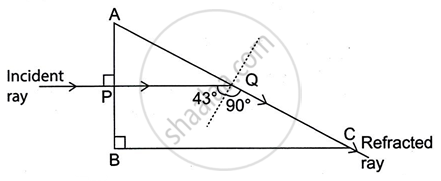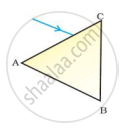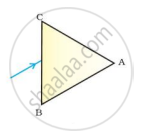Advertisements
Advertisements
प्रश्न
The diagram below shows the path of a blue ray through the prism:
- Calculate the critical angle of the material of the prism for blue colour.
- What is the measure of the angle of this prism (A)?
- Which colour should replace the blue ray, for the ray to undergo Total Internal Reflection?

उत्तर

1. Here, the refracted ray PQ is normal to the surface AB of the prism (i.e., ∠r = 0°), so the incident ray at the point P should also be normal to the surface AB so that ∠i = 0°. At point Q, the angle of incidence for the ray PQ is 133° - 90° = 43°.
Now this angle should be equal to the critical angle because ray PQ is refracted at 90°, i.e., it is refracted along QC.
Hence, the critical angle of the prism is 43°.
2. In ΔAPQ
∠APQ + ∠PQA + ∠PAQ = 180°
90° + 47° + ∠PAQ = 180°
∠PAQ = 180° - 90° - 47°
∠PAQ = 43°
∴ ∠A = 43°
3. The light used and its wavelength determine the angle of deviation. With a decrease in the light wavelength, the angle of deviation increases.
Accordingly, the beam will experience total internal reflection if we swap out the blue light for intense light, sometimes known as indigo light.
APPEARS IN
संबंधित प्रश्न
Write a relation for the angle of deviation (δ) for a ray of light passing through an equilateral prism in terms of the angle of incidence (i1) angle of emergence (i2) and angle of the prism (A).
A ray of light incident at an angle of incidence i1 passes through an equilateral glass prism such that the refracted ray inside the prism is parallel to its base and emerges at an angle of emergence i2.
- How is the angle of emergence ‘i2’ related to the angle of incidence ‘i1’.
- What can you say about the angle of deviation in such a situation?
A light ray of yellow colour is incident on an equilateral glass prism at an angel of incidence equal to 48° and suffers minimum deviation by an angle of 36°.
- What will be the angle of emergence?
- If the angle of incidence is changes to (a) 30°, (b) 60°, state whether the angle of deviation will be equal to, less than or more than 36°?
How does the angle of deviation depend on the refracting angle of the prism?
An object is viewed through a glass prism with its vertex pointing upwards. Draw a ray diagram to show the formation of its image as seen by the observer on the other side of the object.
What should be the angle of incidence for a ray of light which suffers a minimum deviation of 36° through an equilateral prism?
[Hint: A = 60°, i = (A + δmin)/2]
Assertion: The light emerges from a parallel-sided glass slab in a direction perpendicular to that in which enters the glass slab.
Reason: The perpendicular distance between the original path of the incident ray and the emergent ray coming out of the glass slab is called lateral displacement of the emergent ray of light.
In an experiment to trace the path of a ray of light through a glass prism for different values of angle of incidence a student would find that the emergent ray:
A prism ABC (with BC as base) is placed in different orientations. A narrow beam of white light is incident on the prism as shown in below Figure. In which of the following diagrams, after dispersion, the third colour from the top of the spectrum corresponds to the colour of the sky?
Draw a ray diagram showing the dispersion through a prism when a narrow beam of white light is incident on one of its refracting surfaces. Also indicate the order of the colours of the spectrum obtained.




